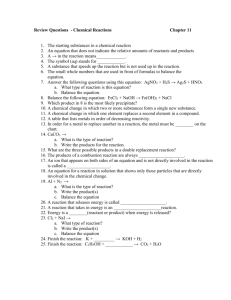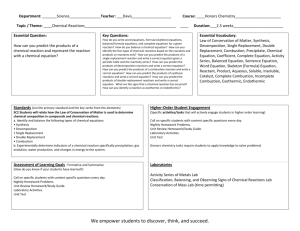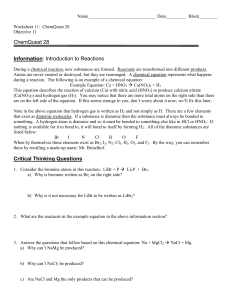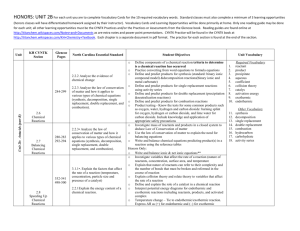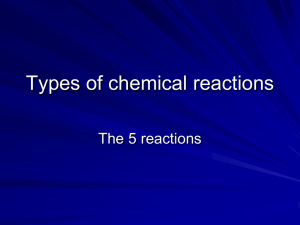chemchap11notes
advertisement
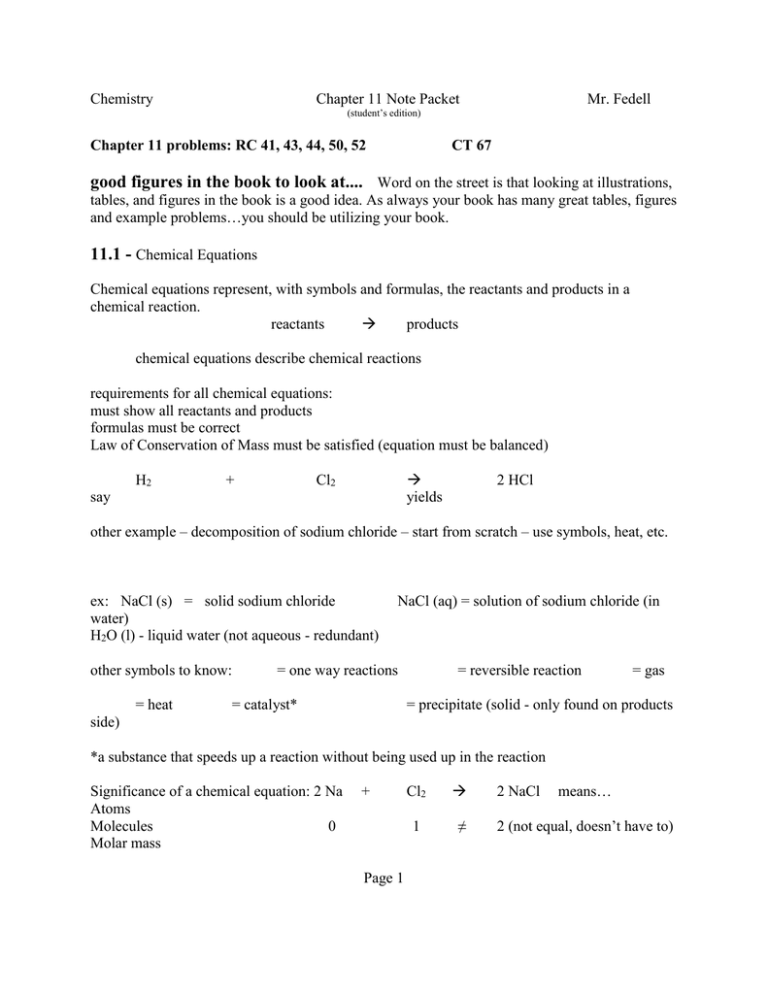
Chemistry Chapter 11 Note Packet Mr. Fedell (student’s edition) Chapter 11 problems: RC 41, 43, 44, 50, 52 CT 67 good figures in the book to look at.... Word on the street is that looking at illustrations, tables, and figures in the book is a good idea. As always your book has many great tables, figures and example problems…you should be utilizing your book. 11.1 - Chemical Equations Chemical equations represent, with symbols and formulas, the reactants and products in a chemical reaction. reactants products chemical equations describe chemical reactions requirements for all chemical equations: must show all reactants and products formulas must be correct Law of Conservation of Mass must be satisfied (equation must be balanced) H2 + yields Cl2 say 2 HCl other example – decomposition of sodium chloride – start from scratch – use symbols, heat, etc. ex: NaCl (s) = solid sodium chloride water) H2O (l) - liquid water (not aqueous - redundant) other symbols to know: = heat NaCl (aq) = solution of sodium chloride (in = one way reactions = catalyst* = reversible reaction = gas = precipitate (solid - only found on products side) *a substance that speeds up a reaction without being used up in the reaction Significance of a chemical equation: 2 Na Atoms Molecules 0 Molar mass + Page 1 Cl2 1 ≠ 2 NaCl means… 2 (not equal, doesn’t have to) Balancing Chemical Equations - truly a trial and error process if there ever was one Helpful hints: 1. 1 atom at a time 2. Balance atoms that appear only 1X per side first 3. Balance polyatomic ions as whole units 4. Balance diatomic elements last 5. Save H + O for last if this doesn’t succeed, try doubling everything (particularly with combustion) Let’s try examples from worksheet 11-1… 11.2 - Types of Chemical Reactions 5 types - synthesis, decomposition, combustion, single replacement, double replacement remember – “first you’ve got to find the right products, then you gotta balance!” synthesis ( ) - needs energy to happen general formula ex. Ba + S Mg + Cl2 Al + Cl2 Na + O2 decomposition ( or ) - needs energy to happen (usually ) general formula ex. FeCl3 HgO MgSO4 · 7 H2O (hydrate) Page 2 combustion - the reaction of hydrocarbons and oxygen to yield...when you just say CHO... general formula ex. combustion of CH4, C3H8, C4H10*, C2H5OH single replacement - take place in solution - need very little energy to happen 2 types: a) General Formula ex + Mg AlCl3 + Ca Ca HOH HI + b) General Formula ex NaCl + F2 BaS O2 + double replacement - again - aqueous solution - little energy - usually forms one soluble ionic product (aka - aqueous) and either a ppt, water, or a gas that bubbles out of water general formula ex. FeCl3 + NaOH H2SO4 + NaOH NH4Cl + NaOH Page 3 Activity Series of the Elements hey, some reactions happen and some don’t for synthesis, combustion, and decomposition, we will assume they all happen given sufficient activation energy ( ) for single replacement, use the Ca + H2O yields Al + H2O yields Al + HI yields Cu + HI yields NaCl + F2 yields NaF + Cl2 yields for the activity series, any single element above an element in a compound will replace it top 5 elements react with metals above H react with the nonmetal reactivity series is for double replacement reactions, use a 1. 2. 3. if one of the products formed is water, the reaction happens if a gas is formed, the reaction happens if an insoluble product forms (I or Ss), the reaction happens (actually a reaction may happen when two soluble products form, but it doesn’t go to completion and is not directly observable) Na2CrO4 + FeCl3 + KOH HCl + NaOH KCl Page 4 NIB - Solubility Trends Cations - very soluble very insoluble- Anions - very soluble for monatomics very insoluble sulfides - general trend - Showing Energy Changes in Equations endothermic - put in heat - write on the ______________ side of the equation or…. exothermic - releases heat - write on the right side of the equation Some helpful notes on writing phases in chemical reactions 1. Metals are solids (except ) 2. In single and double replacement reactions, reactants that are compounds are always aqueous. 3. In single and double replacement reactions, products that are compounds should have their phases identified using a solubility chart (aqueous vs. precipitate) 4. In synthesis and decomposition reactions, ionic compounds are solids. 5. In combustion reactions, the water, CO2, and O2 are gases. The hydrocarbon is hard to tell, but is usually a liquid after C=6 or higher. 6. Most other covalent compounds are gases. 7. Acids (chemicals starting with hydrogen) are always aqueous. Page 5
